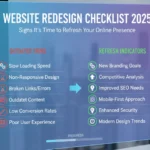Choosing the right WordPress theme is one of the most important decisions you’ll make when building your business website. Your theme determines your site’s layout, appearance, speed, and in many cases, its overall functionality. In this guide, we’ll walk you through key factors to consider to help you choose the perfect WordPress theme for your business in 2025.
1. Identify Your Business Goals and Brand Identity
Start by defining what you want your website to achieve. Are you aiming for lead generation, online sales, bookings, or simply brand visibility? Match these goals to your industry and branding to ensure your theme reflects your business identity. A law firm will need a professional, minimalist design, while a creative agency might benefit from bold visuals and animations.
2. Prioritize Mobile Responsiveness
With the majority of web traffic coming from mobile devices, responsive WordPress themes are essential. Ensure your chosen theme adapts seamlessly to smartphones and tablets. Google also prioritizes mobile-first indexing, so a mobile-friendly theme boosts your SEO rankings.
3. Opt for Lightweight and Fast-Loading Themes
Speed is crucial for user experience and SEO. Select themes known for performance optimization, such as Astra, GeneratePress, or Neve. Avoid themes that come with too many built-in features and bloated code, which can slow down your site.
4. Ensure Compatibility with Page Builders
If you plan to use a page builder like Elementor, Beaver Builder, or WPBakery, make sure your theme supports it. Many modern themes offer full integration, allowing you to create custom layouts without any coding knowledge.
5. Look for SEO-Optimized Themes
An SEO-optimized WordPress theme includes proper HTML structure, fast loading times, schema markup, and mobile responsiveness. SEO-friendly themes help your website rank higher on Google and other search engines right from launch.
6. Check Plugin Compatibility
The perfect theme should work smoothly with major plugins like WooCommerce, WPForms, Yoast SEO, and Mailchimp. Incompatibility issues can lead to broken features and poor performance, especially when adding eCommerce or advanced marketing functionality.
7. Review Customization Options
A good theme offers a robust set of customization features in the WordPress Customizer. You should be able to change colors, fonts, layouts, and header styles without touching code. Some themes even include starter templates for rapid deployment.
8. Consider Support and Documentation
Look for themes backed by professional developers who provide documentation, updates, and responsive support. Premium themes often include six months to a year of support and access to forums and tutorials. This ensures you’re never left stuck when troubleshooting issues.
9. Read Reviews and Ratings
Before finalizing your theme, check user reviews and ratings on WordPress.org or marketplaces like ThemeForest. High ratings and positive feedback from users indicate quality and reliability. Avoid themes with too many unresolved issues or lack of updates.
10. Test Before You Commit
Use the WordPress theme previewer or install a demo version before activating the theme on your live site. This allows you to evaluate how the theme looks with your content, test compatibility with plugins, and review its performance across devices.
Conclusion
Choosing the perfect WordPress theme is a foundational step in creating a successful business website. By focusing on responsiveness, speed, SEO, compatibility, and support, you can find a theme that aligns with your brand and business goals. In 2025, with countless premium and free WordPress themes available, making a strategic choice sets you up for long-term online success.





